German Fighters, Bombers, and Experimental Planes
#16
Getting back to the original planes (no, I'm not trying to change the subject)....the bombers......later in the war, Germany just DID NOT HAVE the men to crew large bomber fleets. They had to concentrate on infantry, tanks, artillery.....and defensive fighters. The U.S., I would submit, probably put WAY too much in the way of resources into bombers, and especially the navy...........By the end of the war, our Atlantic fleet was larger than the entire Royal Navy....and the Pacific fleet was even larger. Bombers (large crews, large support staff, etc.) ate up manpower too.
But there was a price to pay. The U.S., because she put so much into bombers and ships......had trouble staffing the lowly infantry divisions.....and even tank divisions. I think we had a whopping (I'm being sarcastic) 92 divisions of all types (infantry, armored, marine) by the end of the War. Compare that to Germany's 400 divisions......And Russia's numbers which approached 1000 divisions. Because Russia and the Eastern Front tied up so many Germans....we had the luxury of pulling the weight with the navy and strategic bombing. Great Britain ran into the same problem.......Soldiers on all fronts...a large navy....and THEY got into the business of large strategic bombing fleets.
Russia was like Germany. Troops, tanks, artillery, airborne....and mostly tactical fighters and medium bombers.
I know you guys know all this s--t.....but I just like to talk about WWII......
But there was a price to pay. The U.S., because she put so much into bombers and ships......had trouble staffing the lowly infantry divisions.....and even tank divisions. I think we had a whopping (I'm being sarcastic) 92 divisions of all types (infantry, armored, marine) by the end of the War. Compare that to Germany's 400 divisions......And Russia's numbers which approached 1000 divisions. Because Russia and the Eastern Front tied up so many Germans....we had the luxury of pulling the weight with the navy and strategic bombing. Great Britain ran into the same problem.......Soldiers on all fronts...a large navy....and THEY got into the business of large strategic bombing fleets.
Russia was like Germany. Troops, tanks, artillery, airborne....and mostly tactical fighters and medium bombers.
I know you guys know all this s--t.....but I just like to talk about WWII......

#17
I cannot find it right now, but the Germans had a jet fighter on the drawing board that looked like the mixture of a MIG-15 and a F-86 Saber........What would our loss rate of bombers and fighter been like if the Germans had put this plane into service?
The fact is no US, British, or Russian early jet design topped the German jets until the Korean war........with the absorption of all those German aeronautical engineers.
The fact is no US, British, or Russian early jet design topped the German jets until the Korean war........with the absorption of all those German aeronautical engineers.
#18
I'll jump in here and mention air aces.
List of World War II air aces - Wikipedia, the free encyclopedia
I note that the top 100 plus aces were Luftwaffe pilots with Erich "Bubi" Hartmann at 352 kills.
Probably most of these kills were against untrained pilots and poor aircraft of western Europe and Russia.
List of World War II air aces - Wikipedia, the free encyclopedia
I note that the top 100 plus aces were Luftwaffe pilots with Erich "Bubi" Hartmann at 352 kills.
Probably most of these kills were against untrained pilots and poor aircraft of western Europe and Russia.
#19
I cannot find it right now, but the Germans had a jet fighter on the drawing board that looked like the mixture of a MIG-15 and a F-86 Saber........What would our loss rate of bombers and fighter been like if the Germans had put this plane into service?
The fact is no US, British, or Russian early jet design topped the German jets until the Korean war........with the absorption of all those German aeronautical engineers.
The fact is no US, British, or Russian early jet design topped the German jets until the Korean war........with the absorption of all those German aeronautical engineers.
These were the ones that basically was of simmilar design of the F86 and MiG15. These all had one jet engine centrally mounted with an air intake in the nose and a jet exhaust out the back.
Blohm und Voss P.210.01
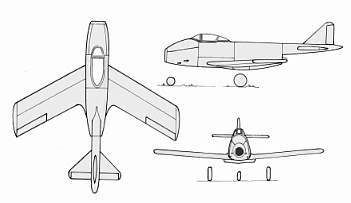
Blohm und Voss P.211/01 - September 14, 1944
Blohm und Voss P.211/02 - September 29, 1944
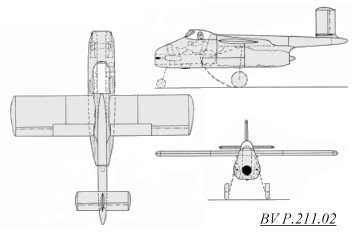
Blohm und Voss P.209/02 - December 1944
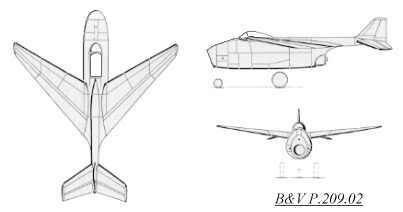
****-Wulf Volksflugzeug - September 18, 1944
****-Wulf Ta183 single jet fighter with HeS 011 - February 1945
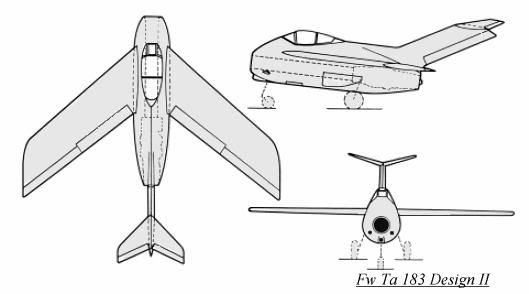
****-Wulf Ta183 design III
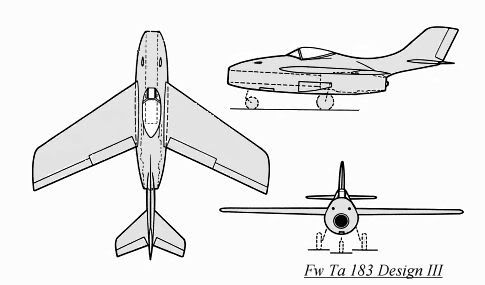
****-Wulf Super TL
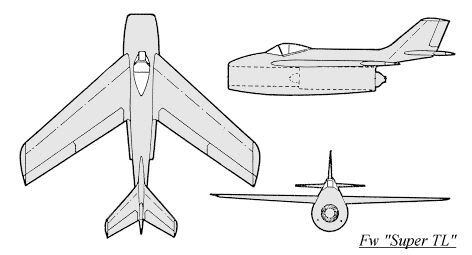
****-Wulf 250
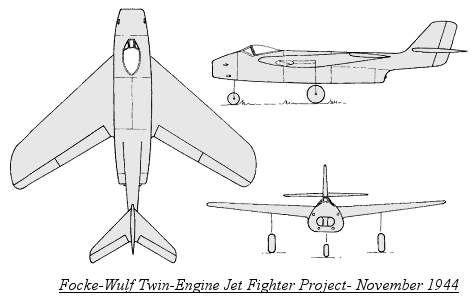
Junkers EF.123
Junkers EF.124 (123 and 124 were known as the Junkers Contender to the Volksjager)
****e-Wulf Night Fighter with two HeS 011 Design III - March 19, 1945
****e-Wulf Night Fighter with three HeS 011 Design IV - March 19, 1945
****e-Wulf Night Fighter with three HeS 011 Design V - march 19, 1945
The one that was closest to the F86 and MiG15 was the Ta183.
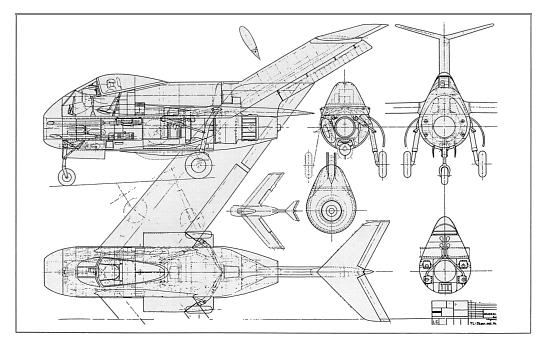
#20
Getting back to the original planes (no, I'm not trying to change the subject)....the bombers......later in the war, Germany just DID NOT HAVE the men to crew large bomber fleets. They had to concentrate on infantry, tanks, artillery.....and defensive fighters. The U.S., I would submit, probably put WAY too much in the way of resources into bombers, and especially the navy...........By the end of the war, our Atlantic fleet was larger than the entire Royal Navy....and the Pacific fleet was even larger. Bombers (large crews, large support staff, etc.) ate up manpower too.
But there was a price to pay. The U.S., because she put so much into bombers and ships......had trouble staffing the lowly infantry divisions.....and even tank divisions. I think we had a whopping (I'm being sarcastic) 92 divisions of all types (infantry, armored, marine) by the end of the War. Compare that to Germany's 400 divisions......And Russia's numbers which approached 1000 divisions. Because Russia and the Eastern Front tied up so many Germans....we had the luxury of pulling the weight with the navy and strategic bombing. Great Britain ran into the same problem.......Soldiers on all fronts...a large navy....and THEY got into the business of large strategic bombing fleets.
Russia was like Germany. Troops, tanks, artillery, airborne....and mostly tactical fighters and medium bombers.
I know you guys know all this s--t.....but I just like to talk about WWII......
But there was a price to pay. The U.S., because she put so much into bombers and ships......had trouble staffing the lowly infantry divisions.....and even tank divisions. I think we had a whopping (I'm being sarcastic) 92 divisions of all types (infantry, armored, marine) by the end of the War. Compare that to Germany's 400 divisions......And Russia's numbers which approached 1000 divisions. Because Russia and the Eastern Front tied up so many Germans....we had the luxury of pulling the weight with the navy and strategic bombing. Great Britain ran into the same problem.......Soldiers on all fronts...a large navy....and THEY got into the business of large strategic bombing fleets.
Russia was like Germany. Troops, tanks, artillery, airborne....and mostly tactical fighters and medium bombers.
I know you guys know all this s--t.....but I just like to talk about WWII......

I'll jump in here and mention air aces.
List of World War II air aces - Wikipedia, the free encyclopedia
I note that the top 100 plus aces were Luftwaffe pilots with Erich "Bubi" Hartmann at 352 kills.
Probably most of these kills were against untrained pilots and poor aircraft of western Europe and Russia.
List of World War II air aces - Wikipedia, the free encyclopedia
I note that the top 100 plus aces were Luftwaffe pilots with Erich "Bubi" Hartmann at 352 kills.
Probably most of these kills were against untrained pilots and poor aircraft of western Europe and Russia.
#21
....I also think alot of those kills were the result of flying from 1939 to 1945. Alot of those kills were also enemy bombers coming to bomb germany late in the war as well. I hardly think it was because they were against untrained pilots and poor aircraft, I just think they were lucky enough to survive long enough that they were able to rack up the kills by shooting down our vast number of bombers as well as our fighters.
#22
I forget the actual number, but the Russians lost some 2000 aircraft (admittedly, a LOT of them on the ground) on the first day of Barbarossa.....and early in the campaign, it was hard to find Russian pilots to stand and fight.....
Obviously that was starting to change by 1943.....

#23
That might have been part of it, sure....But in the case of Germany's aces, it was precisely the presence of outdated aircraft and poorly-trained pilots on the side of the Russians which allowed German pilots to rack up so many kills. This was particularly true in 1941, 1942, and deep into 1943.
#24
German pilots were NOT credited for kills on aircraft on the ground.........
Hartmans total was of only "confirmed" by gun camera, wingmen, and ground forces, in his book "The First and the Last" he claims that those unable to be confirmed kills would have brought him into the 400+ kill range.
Many of his kills were recorded late in the war against both Russian, American, and British fighters, a few in the ME-262, some in the FW-190D9, but by far the most in the ME-109G6. Pilot skill helped him overcome any performance deficit in his 109 to Mustangs and Thunderbolts.......In fact he preferred the 109 over the much better FW-190.
Hartmans total was of only "confirmed" by gun camera, wingmen, and ground forces, in his book "The First and the Last" he claims that those unable to be confirmed kills would have brought him into the 400+ kill range.
Many of his kills were recorded late in the war against both Russian, American, and British fighters, a few in the ME-262, some in the FW-190D9, but by far the most in the ME-109G6. Pilot skill helped him overcome any performance deficit in his 109 to Mustangs and Thunderbolts.......In fact he preferred the 109 over the much better FW-190.
#25
German pilots were NOT credited for kills on aircraft on the ground.........
Hartmans total was of only "confirmed" by gun camera, wingmen, and ground forces, in his book "The First and the Last" he claims that those unable to be confirmed kills would have brought him into the 400+ kill range.
Many of his kills were recorded late in the war against both Russian, American, and British fighters, a few in the ME-262, some in the FW-190D9, but by far the most in the ME-109G6. Pilot skill helped him overcome any performance deficit in his 109 to Mustangs and Thunderbolts.......In fact he preferred the 109 over the much better FW-190.
Hartmans total was of only "confirmed" by gun camera, wingmen, and ground forces, in his book "The First and the Last" he claims that those unable to be confirmed kills would have brought him into the 400+ kill range.
Many of his kills were recorded late in the war against both Russian, American, and British fighters, a few in the ME-262, some in the FW-190D9, but by far the most in the ME-109G6. Pilot skill helped him overcome any performance deficit in his 109 to Mustangs and Thunderbolts.......In fact he preferred the 109 over the much better FW-190.
The only major drag back to the 109 was its very narrow landing gears, it made for a very tricky landing in some cases. Like wise the engine had alot of pull to one side when you applied throttle you had to apply opposite rudder to keep the plane on the runway. But that didnt hurt the 109 performance wise in the air. There was another 109 upgrade to the G model which made the engine more powerful for better high altitude power. They also added a larger fuel tank which only gave a marignal increase in range.
#26
The Grumman F8F 'Bearcat'......Meant to be an 'improved' 'Hellcat'......Used the FW-190 as the base. Designers used a captured FW-190 as the model. It went into service in mid-1945, but never saw combat in WWII. It's often seen as the pinnacle of prop-driven fighter aircraft, and it was used in many conflicts after the War....Not to mention for racing.......
They made that SOB to climb as quick as possible, loaded for bear, and able to smash kamakazi aircraft as far away from the ships as possible......That was the odd thing that struck me. Regarding overall speed, armament, etc......it's VERY comparable to the Corsair (my bird of choice)..........But it could out-CLIMB any other bird out there. For an interceptor (it's main function), that's pretty damned important.
They made that SOB to climb as quick as possible, loaded for bear, and able to smash kamakazi aircraft as far away from the ships as possible......That was the odd thing that struck me. Regarding overall speed, armament, etc......it's VERY comparable to the Corsair (my bird of choice)..........But it could out-CLIMB any other bird out there. For an interceptor (it's main function), that's pretty damned important.
#27
Some people consider the obscure, rare, German TA-152 Fighter to be the pinnacle of Piston driven fighters in WWII.........A highly hopped up, modified version of the the FW-190D9, designed by FW chief design engineer, Kurt Tank and allowed into very limited production in late 44, early 45......Supposedly superior performance to ANY existing piston driven aircraft, and a handful of them with a few Me-262s and 109s/190s kept the skies over Berlin relatively free of the Red Air force fighters and tactical aircraft that outnumbered them 20 to 1, right up till VE day.
The F8F Grumman Bearcat was a hot one!........I think the Hawker Seafury was another really hot piston fighter that never saw service in WWII.
The F8F Grumman Bearcat was a hot one!........I think the Hawker Seafury was another really hot piston fighter that never saw service in WWII.
#28
The P-47 was US`s version of the FW-190, there was one US pilot that just hunkered down in his cockpit as a Me-109 proceeded to fill his plane with every last round he had in his guns. The P-47 still flew even though most of the cylinders in the radial engine had been shot away. This Me-109 came along side rocked its wings and flew off in the other direction. The P-47 was one plane that the germans hated to fight, same with the P-38 Lightning with its five .50 cal machine guns and a single 20mm cannon. Like wise the 262 pilots hated the P-51 Mustang cause that was the number one killer of the 262 jets by pouncing on them while they were landing or just taking off.
Robert S. Johnson - Top P-47 Thunderbolt Ace in WW2
#29
German pilots were NOT credited for kills on aircraft on the ground.........
Hartmans total was of only "confirmed" by gun camera, wingmen, and ground forces, in his book "The First and the Last" he claims that those unable to be confirmed kills would have brought him into the 400+ kill range.
Many of his kills were recorded late in the war against both Russian, American, and British fighters, a few in the ME-262, some in the FW-190D9, but by far the most in the ME-109G6. Pilot skill helped him overcome any performance deficit in his 109 to Mustangs and Thunderbolts.......In fact he preferred the 109 over the much better FW-190.
Hartmans total was of only "confirmed" by gun camera, wingmen, and ground forces, in his book "The First and the Last" he claims that those unable to be confirmed kills would have brought him into the 400+ kill range.
Many of his kills were recorded late in the war against both Russian, American, and British fighters, a few in the ME-262, some in the FW-190D9, but by far the most in the ME-109G6. Pilot skill helped him overcome any performance deficit in his 109 to Mustangs and Thunderbolts.......In fact he preferred the 109 over the much better FW-190.
Erich Hartmann - Biography of Top German Ace of WW2
"The First and the Last" was the autobiography of Adolph Galland, the Luftwaffe's commander of fighters. (an excellent book BTW)
Adolph Galland - WW2 Luftwaffe General of Fighters
#30
Some people consider the obscure, rare, German TA-152 Fighter to be the pinnacle of Piston driven fighters in WWII.........A highly hopped up, modified version of the the FW-190D9, designed by FW chief design engineer, Kurt Tank and allowed into very limited production in late 44, early 45......Supposedly superior performance to ANY existing piston driven aircraft, and a handful of them with a few Me-262s and 109s/190s kept the skies over Berlin relatively free of the Red Air force fighters and tactical aircraft that outnumbered them 20 to 1, right up till VE day.
The F8F Grumman Bearcat was a hot one!........I think the Hawker Seafury was another really hot piston fighter that never saw service in WWII.
The F8F Grumman Bearcat was a hot one!........I think the Hawker Seafury was another really hot piston fighter that never saw service in WWII.
The Fw-190 had a top speed of 426 mph at 21,654 feet and 357 mph at sea level with a range of 520 miles on internal fuel that could climb to 6,560 ft in 2.1 mins and to 32,800 ft in 7.1 mins
The Me-109G/K had a top speed of 387 mph @ 22,967 feet, a top speed of 338 mph at sea level, could climb to 19,868 feet in 6 mins with a service ceiling of 38,551 feet and a absolute ceiling of 39,700 feet.
The P-51 on the other hand had a top speed clean with no racks fitting of 395 mph at 5,000 feet and 413 mph at 15,000 feet. 437 mph @ 25,000 feet and 433 mph at 30,000 feet. Had a max cruising speed of 362 mph, rate of climb of 3,475 feet per min at 5,000 feet, a service ceiling of 41,900 feet with a climb to 20,000 feet in 7 mins 20 seconds and to 30,000 feet in 12 mins 36 seconds.
Over all, I think the best climber for the germans would have to be the Fw-190, the one that could out run basically the P-51 mustang in level flight would have to go to the Dornier Do 335. The Do 335 had good handling and good performance but it just lacked in the climb department.
That story about the P-47 is from the book "Thunderbolt!" (a great book!) by Major Robert S Johnson, who survived the war as the leading P-47 ace with 27 victories.
Robert S. Johnson - Top P-47 Thunderbolt Ace in WW2
Robert S. Johnson - Top P-47 Thunderbolt Ace in WW2

